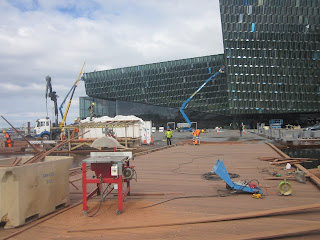June 17 is Iceland's Independence Day, celebrating the formal end of Danish rule on June 17, 1944. The day was chosen because June 17, 1811 was
Jón Sigurðsson's birthday, who is seen as a leader of Iceland's movement for independence (you can read more about him here), and so of course this year being the two hundredth anniversary of his birth there have been a variety of special events. Like the 4th of July in the U.S., June 17th is a big day for celebrating.
 |
That's Jon surrounded by flags.
We enjoyed the festivities in Reykjavík (of course celebrations are held all over the country) which began with the formal government event in front of the parliament building, continued with a procession to the cemetery where a wreath was laid on Sigurðsson's grave. In good democratic fashion, this part also included some protesters, including those who are opposed to Icelandic membership in the EU, and those who are protesting what they see as the lack of accountability after the financial crisis. In the afternoon, the party continued all over the downtown with a parade down Laugavegur, musical and street theater performances, and lots of entertainment for the kids.
Parades in Iceland are fun because they are participatory events. The parade was led by scouts carrying flags, a band, and a street theater, but then everyone joins in the parade. |
A few photos of scenes from the parade.
It was a real family day too, and there were antique cars, a small area with carnival rides, and lots of places for the kids to jump and bounce. These jumping rooms are very popular here and every event seems to have them.
Also lots of cotton candy, and hot dogs, and helium balloons with all kinds of characters. And of course where there are helium baloons, there are children losing their grip on the balloon, and everyone watches it float up into the sky with the sound of a disappointed child in the background.
As I have mentioned before, this year is also the one hundredth anniversary of the Unviersity of Iceland, which for the first thirty years, from 1911 to 1941, met in the parliament building. So the building was open in honor of that anniversary, and it was fun to see the building in general (which is not often open to the public) and in particular to see the rooms where university classes met.
 |
One of the rooms where University of Iceland
classes met at the parliament building. |
The best part of the day was just being part of the generally positive spirit of the celebration, Icelanders celebrating their Icelandicness.
Two days later, on June 19, we attended another celebration, much smaller in scale, and with a different focus: to mark the anniversary of women gaining the right to vote in Iceland in 1915. (Actually originally it was just women who were over 40; then the age was gradually reduced over the next few years).
The event began at the cemetery, with music and readings and a wreath-laying at the grave of
Bríet Bjarnhéðinsdóttir (1856-1940) who is seen as the founder of the women's rights movement in Iceland. Among other things, she was the first woman to give a public lecture in Iceland, founded the feminist paper
Kvennablaðið, and was a founder of the Women's Rights Association in 1907. The ceremony in the cemetery was followed by a procession to the women's rights association building and a series of short lectures on women's rights in Iceland, historically and in the present. The lectures were in Icelandic of course so I only understood a little bit but it was great to be a part of the event.
There is a monument to
Bríet in downtown Reykjavik, notable for its lack of a statue. I was told that it was designed this way because there is not a single statute of a woman in Reykjavik, and so the monument is partly a commentary on that. And of course, although nearly every museum that we have been to this year has had some kind of exhibit about Jón Sigurðsson (including the folk museum in Ísafjör
ður which has an exhibit about the book that he wrote about fishing and the fishing industry), I don't recall seeing any mention of
Bríet Bjarnhéðinsdóttir. But at least there is a memorial. In the U.S. the statues of suffragettes donated to the U.S. government were hidden away from public view for 75 years. Iceland still rates very high on measures of gender equality, and this is reflected in public policy and in people's attitudes to gender equality, despite continuing issues such as pay equity.
So two very different celebrations, and a fun and interesting way to spend a weekend in June.





















































